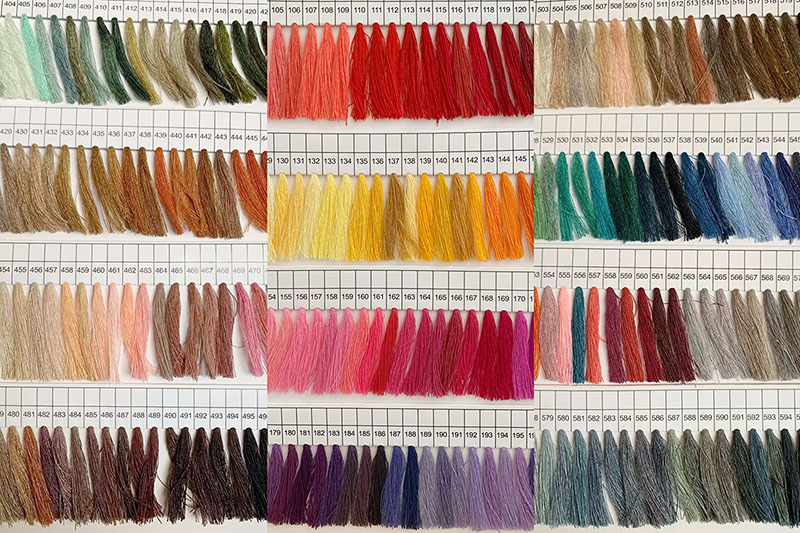
- English
- Español
- Português
- русский
- Français
- 日本語
- Deutsch
- tiếng Việt
- Italiano
- Nederlands
- ภาษาไทย
- Polski
- 한국어
- Svenska
- magyar
- Malay
- বাংলা ভাষার
- Dansk
- Suomi
- हिन्दी
- Pilipino
- Türkçe
- Gaeilge
- العربية
- Indonesia
- Norsk
- تمل
- český
- ελληνικά
- український
- Javanese
- فارسی
- தமிழ்
- తెలుగు
- नेपाली
- Burmese
- български
- ລາວ
- Latine
- Қазақша
- Euskal
- Azərbaycan
- Slovenský jazyk
- Македонски
- Lietuvos
- Eesti Keel
- Română
- Slovenski
- मराठी
- Srpski језик
Conversion Chart for Embroidery Thread: An Indispensable Tool In The Embroidery World
2025-02-20
Embroidery thread conversion charts are essential tools for anyone working with machine embroidery. Different brands use different numbering systems and color names, so these charts help you find the equivalent thread in a brand you prefer or have on hand. Here's a breakdown of what you need to know and how to use them:
The Reason For The Need For Conversion Charts
Each line manufacturer (e.g., Madeira, Sulky, Robison-Anton, Isacord) has its own unique color numbering system. Like the "red" on one brand may be slightly different on another brand and not meet your color requirements. And embroidery designs often specify a specific brand of thread color. If you don't use this brand, you need to find an equivalent brand. But the exact brand may not be specified at the local store, or a specific color may be out of stock. Conversion tables can then help you find alternatives and find the quality or price of a particular brand you like.
The way to use a Conversion Chart:
Using thread transformation graphs effectively requires a few simple steps. First determine your existing thread brand, thread number, and thread color. Then, using the chart, find the equivalent color of the brand you want to switch to. It must be noted that while the chart provides a close match, there may be some slight color changes.
Accuracy is important. Whenever possible, always compare thread samples in natural light. This practice ensures the closest match and maintains the integrity of the project. Also, carrying a physical chart with you may be more beneficial than relying solely on a digital version, as screen colors may vary.
Key Features of a Good Conversion Chart:
Conversion Chart should include a wide range of popular embroidery thread brands. Conversions should be as accurate as possible to minimize color differences. (Note: Due to changes in dye batches, it is sometimes impossible to match exactly.) Charts should be easy to read and navigate, with clear branding and color labels. Ideally, the chart will give each thread a color name and a number, since numbers are the most accurate way to identify a color. Line manufacturers occasionally change their color lines, so it is important to use the latest version of the chart.
Where to Find Conversion Charts:
Online Search: Search for "embroidery thread conversion chart" to find numerous printable or online charts. Be sure to check the date or version of the chart to ensure it's relatively current.
Thread Manufacturer Websites: Many thread manufacturers offer conversion charts on their websites, often specific to their brand and its equivalents in other brands.
Embroidery Software: Some embroidery software programs include built-in conversion charts.
Embroidery Supply Stores: Local embroidery shops or online retailers may offer printed conversion charts.

Important Considerations:
Even within the same brand, slight color variations can occur between different dye lots. If color matching is critical, try to use threads from the same dye lot.Some embroidery software and even online tools allow you to upload a color and they will suggest matching threads across brands. These can be helpful but always double check the results.While charts are helpful, it's always a good idea to visually compare the converted thread to the original color if possible, especially for critical projects. You can often purchase sample cards of thread colors.Be aware that a perfect match is not always possible. You may need to choose the closest equivalent and accept slight variations.
By understanding how to use embroidery thread conversion charts, you can expand your thread options, save money, and ensure your embroidery projects turn out beautifully.The future of machine embroidery is intertwined with technological advancements. Innovations in thread production are paving the way for more vibrant, durable, and eco-friendly options. These developments are expected to expand the capabilities of existing machines, allowing for even more intricate designs.


